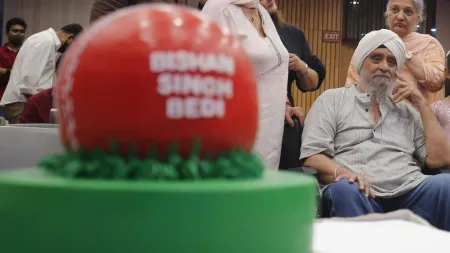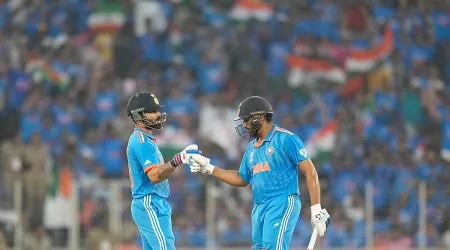- India
- International
The humble Birmingham Balti, with its roots in Kashmir, becomes a hit with CWG athletes
A Balti prides itself in sticking to its onion-tomato base, is cooked in something that’s shaped like a kadahi, but is made of pressed steel like a lightweight wok.
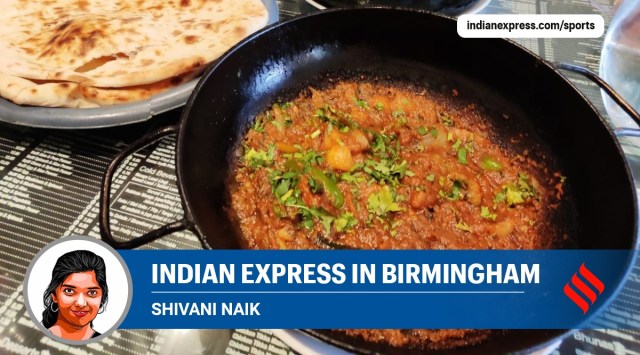 Birmingham's Balti restaurants have attracted athletes and officials from several countries, including India and Pakistan. (Credit: Shivani Naik)
Birmingham's Balti restaurants have attracted athletes and officials from several countries, including India and Pakistan. (Credit: Shivani Naik)It’s the unpretentious coriander garnish – not an artistic sprinkling for a colour contrast, but freshly chopped unevenly, for flavour – that sets the tone. In what cocks a snook at the pervasive trends of aesthetic ‘plating’ meant for Instagram and televised cook shows, Birmingham’s Balti restaurants have remained authentic to their roots, and have been quite a sleeper hit with Commonwealth Games athletes and officials, in the vicinity of the city’s Balti Triangle – that’s Pershore Road, Ladypool Road and Moseley Road.
“Athletes from India, Pakistan, Scotland, Ghana, Kenya and South Africa have dropped in for our Balti,” says Imran Ali, owner of the Royal Watan at Selly Park’s Pershore Road. Lassawala Gosht (Lassawala chicken balti) is a Royal Watan hit this summer, and it sources spices for its special garam masala from the owner’s Lassa native village in “Azad Kashmir” (POK). “We get the basic masalas that are grown and ground back in our village. And I’d like to believe that makes our gosht unique. My ammi still makes the same recipe once every week,” Imran says.
Those walking into this Balti for a proper meal – mostly dinner, have returned for their masoor ki daal besides the signature Lassawala chicken balti, and like a bunch of other Baltis, claims to be one of the only handful of Baltis to have survived the pandemic, while continuing to attract celebrities and regular diners.
A Balti prides itself in sticking to its onion-tomato base, is cooked in something that’s shaped like a kadahi, but is made of pressed steel like a lightweight wok. The subtle charring is not dressed up, but diners are encouraged – as an authentic Balti experience – to mop it up with the giant soft chewey naans, eaten straight off the balti it is cooked in.
🇦🇺 Our Australian group learned more about the famous Balti at Shababs in #Birmingham‘s famous Balti triangle. pic.twitter.com/w16TwmShrI
— West Midlands Growth Company (@WMGrowth) August 1, 2022
Forget fancy plating; it’s uncool to ask for plates at a Balti, as communal eating with the hands, is the original Balti cred. In the area known as Birmingham’s Balti Triangle, where the subcontinental diaspora is omnipresent, the neighbourhood has shopfronts with wedding finery – lehengas in pastels, and strains of Kumar Sanu’s obscure ditties, streaming out of boom boxes. But the Balti experience, is essentially about the food, eaten without any pretension.
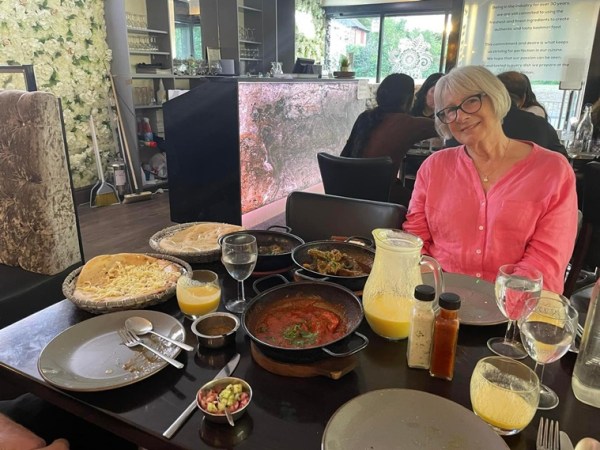 Birmingham’s Balti restaurants have attracted athletes and officials from several countries, including India and Pakistan. (Pic: Shivani Naik)
Birmingham’s Balti restaurants have attracted athletes and officials from several countries, including India and Pakistan. (Pic: Shivani Naik)
History of Balti

Mohammed Arif of Ladypool Road is credited with Birmingham’s first Balti in 1977, according to ‘Going For a Balti’ by Brummie man and Balti obsessed-author Andy Munro. Arif arrived in Bradford as a child from Kashmir, to which the Balti owes its origins, learnt English in evening school and worked in a textile factory. After working at his uncle’s Green Lane restaurant in Birmingham where he had a 35p curry and 2p roti on the menu, he would start his own eatery to cater to the factory workers who came in from the subcontinent, and Balti chefs held the earliest unofficial IP tags in kitchens.
Arif used the word balti, to quote Munro, because it was easier to pronounce than karahi and it meant a bucket – a receptacle used in Indian weddings to hold large amounts of food. The Balti came about in England’s metal city in seredipitious ways.
“The English diners who took a liking for it, wouldn’t wait for an hour for a slow cook, so they needed something that could heat up far quicker than a heavy cast iron karahi but could withstand the direct and high heat which would crack a clay pot,” Munro writes.
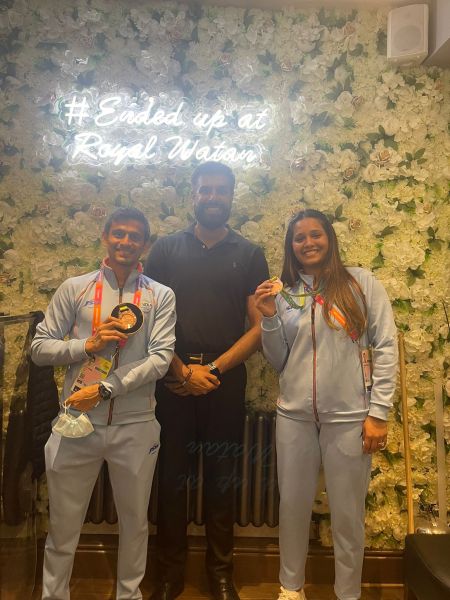 Imran Ali, owner of the Royal Watan with Indian squash player Saurav Ghosal and Dipika Pallikal.
Imran Ali, owner of the Royal Watan with Indian squash player Saurav Ghosal and Dipika Pallikal.
Birmingham then was still famous for metal bashing, and Arif found a firm called Pressform at Smethwick, owned by a Sikh Tara Singh, an inventor or innovator of his times. “Arif asked Tara to make something shaped like karahi but made of pressed steel like a lightweight wok. Tara rolled out a two handled metal pan, a flat bottomed receptacle which formed the balti brainwave.”
It was fast-cooked curry, cooked over a high flame, burnt off the vegetable oil, that accentuated spices, and was served in the balti bowl it was cooked in. Munro lists out the most common Balti recipe with a base of tomato, onions, fenugreek seeds, turmeric, ginger garlic puree, cumin, garam masala, and garnished with the unhidden fresh coriander. “Baltis got westerners to eat naan to mop up the sauce … Mopping up the most polishing off organic experience than dining out,” Munro writes.
He speculates if Balti had word roots to Hindi balti (bucket) or Portuguese balde (small two handled pan used in balti house), but it would take off in the Western Midlands, just like a Glasgow restauranter would popularise ‘chicken tikka masala’ up north. Munro claims in around here, ‘going for a balti’ became more of an icebreaker than talking English weather.
Balti wars
The Balti triangle boom of one-pot curry, also had a necessary sequel of Balti wars at Moseley road, where different Baltis indulged in espionage, stealing of chefs and comparative pricing to outdo each other. Food remained flavoursome, never mind the rancour, just like Black Sabbath music remained unabashedly rock. The caramelised onions were allowed to burn to their logical destruction to squeeze out the flavour.
While chicken, mushroom, spinach Balti went beyond the favoured chicken, lamb and paneer staples, Baltis didn’t dabble at using carrots or peppers. “Only chilli, onion,” Imran says. “No sweet,” he says, crinkling his nose. Sher Khan, Tipu Sultan, Arifs became Balti monsters, some grooving into the fine dine space. “English, Indian and Pakistani teachers of the nearby two nursery schools, regularly drop in for Balti lunches,” says the owner of Shababs Balti, who also has had BBC’s celebrated chef whisk up a Hairy Biker Chicken Balti. Employees of nearby Land Rover facility are also regulars, and Baltis usually come alive at 2 a.m in full houses.
For athletes and officials, it’s familiarity with a flavour they never left behind, eaten the only way Balti-naan ought to be eaten: with hands, straight off the Balti cook-serve bowl.



















